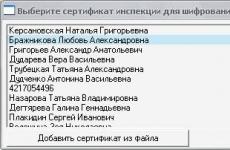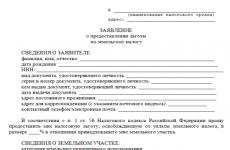How to calculate the vehicle tax for horsepower. Vehicle tax
and now there are usually not many questions.
Legislative (normative) base for the transport tax on cars in Moscow and the region
Transportation tax is regional taxregulated by the Tax Code Russian Federation (Chapter 28) and the laws of the subjects of Russia.Please note that this is a tax on owning a motor vehicle, and not taxes arising from car purchase transactions.
In everyday life, this tax is also often called motor, road or road tax.
Transport tax is levied on registered cars, motorcycles, scooters, buses and other moving, flying and floating cars. The following discussion focuses only on cars, designed for individuals in Moscow and Moscow region.
The tax on personal vehicles is calculated annually for the full calendar year.
Notification with the calculation of the amount of tax for the past year and a receipt for payment are sent to the owners of cars by the tax service.
How to calculate the tax on the car
The formula for calculating the tax on a passenger car: N = MD * S * M / 12 * Kwhere The final tax amount depends on.Fully tax must be paid before the first of October next year.
Tax on horsepower (l / s)
The basis for calculating the autoalog is the engine power of the vehicle expressed in horsepower.The Russian Tax Code establishes tax rates by type of vehicle. The tax rate for cars is measured in rubles per horsepower (abbreviated as rubles / hp).
It does not depend on the model, brand, country of production (place of assembly) of the car and grows progressively with an increase in the number of engine horsepower.
The change in the rate is “hopping”. Set intervals: less than 150 hp; 150 hp - 200 hp; 200 hp - 250 hp and over 250 hp
Base rates are approved at the federal level, and already specific tax rates used in calculating tax for car owners are established by the laws of the constituent entities of the Russian Federation.
Observing the legal restrictions of the Tax Code, each region has the right to determine the dependence of the tax on horsepower.
For vehicles with engines over 150 hp change from baseline is limited to a tenfold decrease or increase. That is, theoretically, tax on horsepower on the same machine in different regions may differ by a hundred times.
For less powerful cars there are no restrictions for regional authorities.
For example, in Moscow cars up to 70 hp are not taxed at all.
The upper limit of the rates for low-power passenger cars is limited by an understanding of a priori progressiveness of horsepower and, accordingly, cannot exceed the rates for cars with a capacity of more than 150 hp.
In addition to the power of the motor, the road tax rate may be related to the year of production of the machine and its environmental class.
.
Tax on passenger cars in Moscow and Moscow region is calculated on the basis of horsepower of the engine.
Transport tax, unlike land tax and property tax, is not a local, but a regional tax. therefore road tax rates may differ in different subjects of Russia, but the same in all areas of the same region (region).
The stakes in the capital are determined by the Law of the City of Moscow “On Transport Tax”. In the Moscow region - the Law of the Moscow region "On transport tax in the Moscow region".
Tax rates do not grow in direct proportion to the strength of the engine, but “stepwise”. In Moscow, as in Tax code, the gradation of rates in the main range (from 150 l / s to 250 l / s) is 50 l / s, in Moscow - 25 l / s.
Rate table on horsepower of cars in Moscow and Moscow region
* The upper bound is included in the power range, and the lower is notWhere to find the tax rate for cars
All information on vehicle tax rates can be found in the “Reference information on property tax rates and benefits” section of the Tax Service official website.To do this, mark the type of tax and select the appropriate region (Moscow - "77", Moscow region - "50").
Tax exemptions for cars in Moscow and the Moscow region
At the federal level, transport tax benefits are established by the Tax Code. Avtoalogalog not subject to:- cars specially equipped for use by disabled persons;
- cars with engine power up to 100 horsepower, acquired or obtained through social security agencies.
In Moscow, Heroes of Russia, veterans, disabled people and “Chernobyl residents” do not pay road tax for one car up to 200 hp.
In the Moscow region for passenger cars Heroes of Russia, veterans and disabled people, the limit is 150 hp.
Transportation tax for retirees
Ordinary pensioners (by age) do not have road tax exemptions in Moscow and Moscow region.In Moscow and the region, one of the parents in a large family has the right not to pay a car tax for one car.
Benefits are granted to Moscow owners of small car. Cars with engine power up to 70 horsepower are not inclusive of motor vehicle tax.
Tax legislation on motor tax is not yet “in trend” in the matter of support for import substitution. Special benefits for owners of domestic cars, as well as targeted multiplying factors for foreign cars have not been established.
More complete information on regional and federal privileges on autoalog can be found on the website www.nalog.ru in the reference information on privileges on property taxes or directly acquainted with the texts of regional laws.The privileges for Moscow car owners are established by the Law of Moscow “On Transport Tax”, and for those in the suburbs - by the Law of the Moscow Region “On preferential taxation in the Moscow Region”.
How to calculate the number of months of owning a car
A car, unlike real estate, changes its owner more often. How to determine the number of months of tax payment, if you sold or bought a car within a year?The tax accrual period is determined by the dates of registration of the car and its removal from the register in the traffic police (traffic police), and not the dates of the purchase / sale of the car. At the same time, the month in which they were registered, as well as the month in which they were removed from registration, are considered to be a full month.
If you have delivered and deregistered within one calendar month, then the tax is paid for one month.
Example. You registered the car on April 2, and deregistered on November 12 of the same year. The number of full months of ownership - 6 (May, June, July, August, September, October). Plus months of arming and deregistration (April and November), which are also considered as full months of ownership. Total it turns out that in this year the tax will be charged for 8 months.
It is worth noting that in the month of purchase and sale of the car, if the car was immediately registered, the tax is paid by both the old and the new owner of the car.
Secondly, when buying a car should be borne in mind.
Finally, the tax collection period is not infinite. Just three years. So in 2015, you can make claims for 2012, 2013 and 2014 and are not entitled to touch the road autoalog for 2011.
Owners of various types of transport are required to promptly deduct tax for it to the budget. And for each subject of the Russian Federation has its own vehicle tax rates. What factors work in 2016 (and, most likely, will switch to 2017), what they depend on and how the calculation takes place - in our review.
Payment essence
The tax on cars appeared in the Tax Code of the Russian Federation in 2003. Its economic meaning is compensation for damage to the environment and road surface. A similar function is performed by excises on gasoline and fuel.
Most states have refused to introduce a transport tax. It is replaced by other types of contributions: environmental, road or fee for movable property.
Transport tax is a payment made to the Russian budget. It is obliged to make it not only individuals, but also legal entities, as well as individual entrepreneurs. The rate set by the regional authorities.
Baseline values
To understand how to determine the vehicle tax rate, the legislation defines the basic coefficients on the basis of which the calculation takes place for individual regions of our country. They are presented in Art. 361 of the Tax Code of the Russian Federation (see figure below). It is permissible to increase or decrease their value maximum - 10 times. The exception is vehicles with a capacity of less than 110.33 kW.
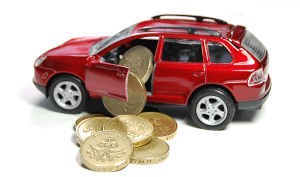
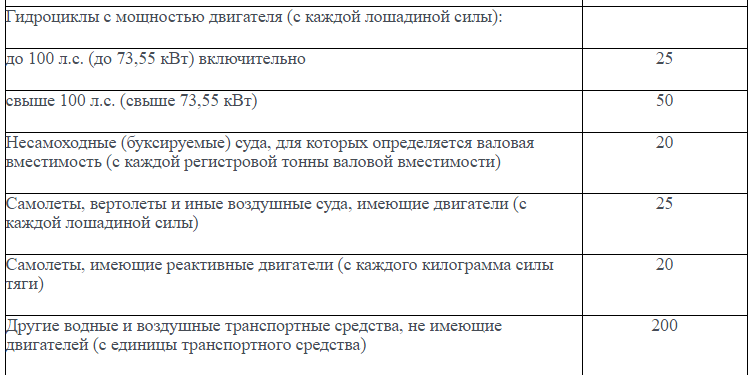
In 2015 - 2016 vehicle tax rates virtually unchanged. For example, in St. Petersburg the following indicators were established (on the basis of the Law No. 583-106):
What depend on vehicle tax rates
Certain factors influence the calculation of fees for each type of transport.
Vehicle category
The legislation provides for differentiated rates for different categories of transport. According to Art. 361 of the Tax Code, these include:
- ground vehicles - trucks, buses, scooters, etc .;
- water – yachts, ships);
- air - helicopters, airplanes.
Sometimes it is not possible to uniquely identify a category. Then we recommend that you familiarize yourself with the regulatory documents:
- UNECE UN Inland Transport Committee classification;
- GOST R 51709-2001 (Resolution of the State Standard No. 47-st);
- Convention on Road Traffic.
Specifications
Magnitude vehicle tax rates for land transport depends on engine power. It is found by the formula:
P = PkW × 1.35962
P - power, measured in horsepower (hp);
RkW - power in kilowatts.
The result is rounded according to standard rules.
Tax on water transport depends on the total capacity and the unit of the vehicle (the information should be in the technical documents). In the absence of such indicators, you can also use the opinion of a respected expert in this field (see the order of the Ministry of Taxes and Tax Collection No. BG-3-21 / 177).
For some types of vehicles, the calculation is made from each kilogram of thrust force. For example, when paying a tax for a helicopter.
Date of issue
Has an impact on vehicle tax rateif such a requirement is regulated by normative acts of the region. Features of the calculation:
- the calculation starts from January 1 of the year following the vehicle’s production date;
- take into account the period for which the payment is made;
- days are calendar days (working days, weekends and holidays are taken into account).
Environmental class
Insofar as vehicles are a source of environmental pollution, in 1992, legislative measures were taken, informing about the composition of harmful substances in exhaust gases. Special codes have been developed - environmental safety standards (see table).
| Class | Explanation |
| Euro 1 | Standard controlling the level of carbon, nitrogen, hydrocarbons |
| Euro 2 | It provides for the reduction of toxic substances by 3 times compared with the first class. In some large cities restricted entry of transport, not falling under this standard. |
| Euro 3 | Contains information about the content of harmful substances not only for passenger cars, but also for transport with diesel engines. Compared with the previous class, harmful substances should be reduced by 30 - 40%. |
| Euro 4 | It has more stringent requirements for the level of toxicity of exhaust gases - up to 40%. Valid for six years. |
| Euro 5 | A modern standard introduced 8 years ago for trucks and cars imported from EU countries. |
The environmental class is clarified in the process of acquiring a vehicle and issuing relevant documents. It must be listed on the data sheet. But if such information is not available, you can use the databases on the Rosstandard website.
How to determine the vehicle tax rate: calculations
To determine the tax for your vehicle, you must perform the following steps:
- Refine the indicators discussed above, correlating them with the technical passport.
- In the register of indicators established for the subjects of the Russian Federation, choose a car that will correspond to the characteristics of your vehicle. It contains the rate.
Tax can be calculated in different ways, but depending on the duration of ownership of the vehicle.
When the car is at the disposal of a person for one year, use the standard formula:
S = N x K
S is the sum of the transport tax;
N - the rate established for a specific region;
K - power (hp).
If the period from registration to the date of tax was less than a year, the calculation is as follows: 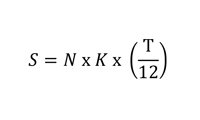
T - the number of full months during which the vehicle belongs to man.
Keep in mind: vehicle tax rate Must be spelled out in the notification sent by the inspection. Here is how the tax in question is presented: 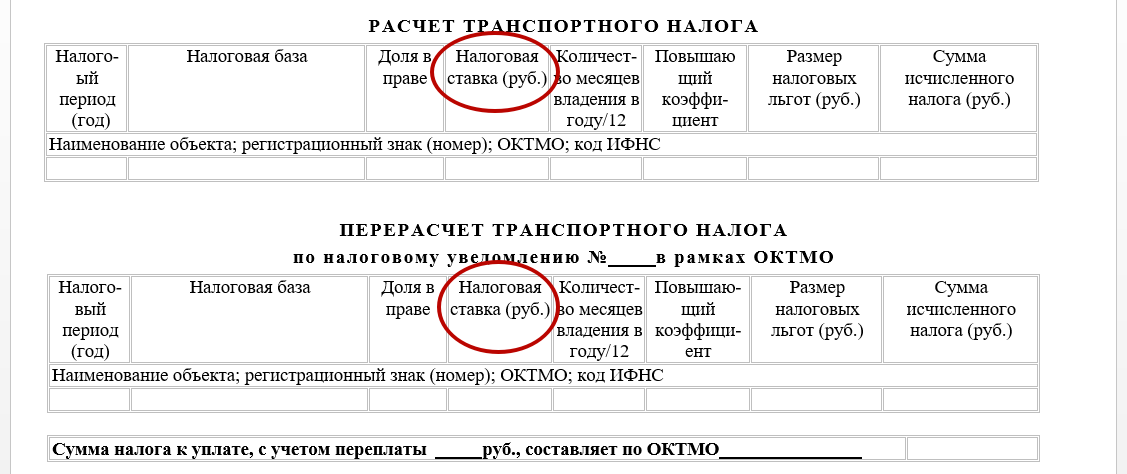
Increased ratio for expensive cars
In 2016, lawmakers introduced a higher rate for calculating the tax on luxury cars. The calculation formula will differ depending on the duration of the vehicle ownership (see table).
Note: when the Ministry of Industry and Commerce issues a new list of expensive vehicles, and the tax is paid according to the previously existing rules, no correction is required.
The following link provides the official list of cars for 2016, which the Ministry of Industry and Trade considers expensive: http: //minpromtorg.gov.ru/common/upload/files/docs/Perechen_2016_dlya_publikatsii.pdf
EXAMPLE
In October 2015, Leonov, who lives in the Novosibirsk region, bought a Lada 21051 car. In September 2016, he received a notice from the tax inspectorate on the payment of vehicle tax. How to calculate the vehicle tax?
Baseline data are presented in the table.
Decision
Leonov needs to determine the category to which the transport belongs, and capacity. The obtained information should be compared with the rates applicable in the Novosibirsk region in 2015. The calculation will be as follows:
59 × 6 × (3/12) = 88.5 rubles.
Based on the laws of the NSO № 280-ОЗ, № 281-ОЗ, № 370 and others, Leonov must pay transport tax for last year in the amount of 89 rubles. This should be done no later than December 1, 2016.
How else to check the calculation
You can determine car tax using online calculators. The user must select the type of vehicle, power, set the date of registration (at the disposal of the vehicle for less than a year). If necessary, indicate the period of deregistration. The calculation takes place automatically.
For example, such a service is on the official website of the tax service at the address (link for Moscow): www.nalog.ru/rn77/service/calc_transport 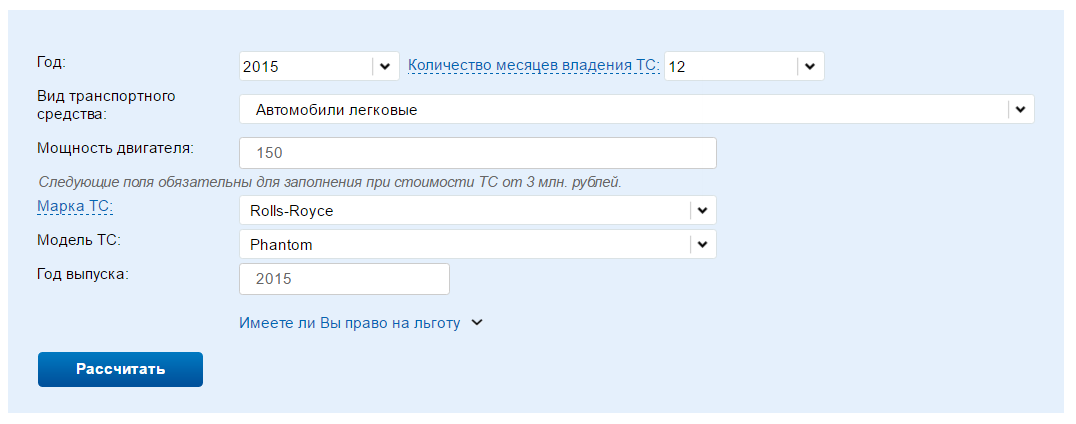
If you find an error, please highlight a piece of text and click Ctrl + Enter.
In Russia, owners of any type of machinery, except agricultural, must pay an annual transport tax, which covers the cost of road repairs and their maintenance, as well as environmental damage.
For example, benefits for disabled people of the 1st and 2nd groups, exemption from tax when the engine power is less than 70 hp. etc. - this should be clarified in tax inspection at the place of residence.
How it depends
The amount of tax paid depends on the amount of horsepower in the engine - the more, the more you need to pay.
For example, the tax on cars and trucks changes every 50 hp. For other vehicles, there are usually 2 points of separation - up to 100 and more than 100 hp. Sometimes the criteria for the separation of the vehicle are missing.
Also, the legislation adopted amendments to the law on luxury, making a list of vehicles for which you should pay increased taxes, which caused a lot of discontent among the population.
How to calculate
Ordinary citizens do not need to independently calculate the transport tax, as this is done by the tax inspectorate.
But it establishes that individuals must themselves register their vehicle, on which tax is subsequently charged.
If the vehicle is not registered, a fine will then be charged to its owner.
Legal entities must themselves calculate their transport tax and submit tax information on time, otherwise they will be given penalties.
Get the amount of tax for 12 months. If you registered a vehicle less than a year ago, then the tax will be correspondingly less.
For example, a car has a power of 123 hp. and registered 8 months ago. The tax will be as follows:
3,5 rub. (we take the all-Russian rate) * 123 * 8/12 = 287 rubles.
If, after registering the vehicle, its engine was replaced, as a result of which the device had other power, this should be reported to the traffic police department at your place of registration and write a corresponding statement.
Then in the future transport tax will be calculated on the basis of new data.
Previously, control over the payment of taxes was on the traffic police, without a receipt from which it was impossible to pass a technical inspection that threatened fines to the vehicle owner.
Because of this, there were few tax breaks.
At the moment, the tax authorities fully control this process.
Now even those people who did not pay tax are obliged to do this. After all, if a person has a broken car that simply stands idle in the garage, he doesn’t need a technical inspection certificate, so he did not want to pay the tax.
Some of them passed technical inspection illegally, without providing a traffic police receipt.
Now, any owner of a vehicle that is registered must pay tax on it. Therefore, the traffic police recommends removing from the register those cars that are broken, hijacked or for some other reason are not functioning at a given time.
Also be careful when selling a car by proxy - if the new owner does not put it on his account, then the tax will come to you, and failure to pay it threatens to charge a fine in the amount of 1/300 of the central bank refinancing rate for 1 day stitching.
If for any reason you do not use your vehicle, sold it by proxy or it does not exist at all (hijacked, sold for parts, etc.), but which is registered with the traffic police, collect all the necessary documents to prove this and contact tax authority at the place of registration.
Transport tax must be paid to each vehicle owner, which is in the list of the Tax Code.
The size of the tax, as well as benefits for it, is established by the subjects of the Russian Federation independently. But in general - the more horsepower (power) in the engine - the more will be tax rate for a citizen.
Also, some vehicles are included in the category defined by law as a luxury, because they need to pay an increased transport tax.
You should closely monitor the transport registered to you, as the tax must be paid, even if the car is faulty.
Video: Horsepower Tax
Transport tax is charged exclusively on those who have registered their vehicle. It is regional, and therefore it must be paid at the place of registration of the equipment.
 According to article 357 of the Tax Code of the Russian Federation, taxpayers are those persons on whom vehicles are registered. But the amount of tax is set by the tax service. It should be paid not only by individuals, but also by legal entities, as well as various companies and enterprises.
According to article 357 of the Tax Code of the Russian Federation, taxpayers are those persons on whom vehicles are registered. But the amount of tax is set by the tax service. It should be paid not only by individuals, but also by legal entities, as well as various companies and enterprises.
So, what kind of vehicles taxed:
- vehicles that are tracked or pneumatic;
- air Transport;
- water.
However, there are other objects that not subject to TN. It:
- boats that are equipped with a motor or oars and have a capacity of up to 5 hp;
- cars that either have a capacity of up to 100 hp or are specially equipped for people with disabilities of various groups;
- river vessels that are directly related to the fishing category;
- vessels carrying passengers, if they are privately owned by an individual entrepreneur or a legal entity;
- agricultural transport;
- watercraft, issued in the international registry.
The legislation clearly states that a VAT is charged only on vehicles that are registered officially. At the same time, the law began to operate from the beginning of 2003.
TN charged to citizens in accordance with Chapter 28 of the Tax Code. It is paid by those citizens on whom the vehicle is registered. This clause is spelled out in article 357.
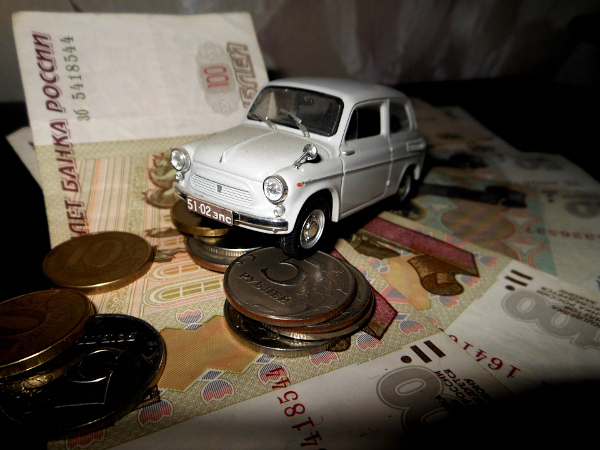
Sample search
In order to find the tax rate, you must perform the following steps:
- Go to the website of the tax service nalog.ru.
- Choose a suitable area.
- Find the vehicle in the table (determine which group it belongs to - cars, trucks, motorcycles, etc.).
- Find in the documents issued on the car, engine power and find it in the table.
- Opposite of power and there will be a current rate.
For example, you live in the Samara region and are the owner of a car with a capacity of over 150 hp. In this case, your rate will be 43 rubles.
Table in Russia and regions for 2017
Below you can see exactly how the rate table will look for a particular area. However, in more detail for each region the tables are painted on the website of the tax service nalog.ru.
We should also talk about rates in the Moscow region. In 2014, it was decided that the transport tax rates will be slightly increased. For example, if in 2014 in Moscow the rate on a passenger car up to 100 hp was only 7 rubles, now it has increased to 10 rubles. However, the rates for 2016 and 2017 remained the same.
Nobody has canceled tax breaks. However, now, in order to take advantage of such a “bonus”, you need to be the owner of a car whose power is less than 200 horsepower. The reason for this - a large number of people with disabilities and other beneficiaries who own sufficiently powerful vehicles.
Below are a few tables from which you can get information about the rates for vehicles in the Moscow region in 2017.
| Trucks with engine power (each horsepower) | Rubles |
|---|---|
| With age up to 5 years | |
| 20 | |
| 25 | |
| 33 | |
| 45 | |
| 58 | |
| With age over 5 years | |
| up to 100 liters. with. (up to 73.55 kW) inclusive | 25 |
| over 100 l. with. up to 150 l. with. (over 73.55 kW to 110.33 kW) inclusive | 32 |
| over 150 l. with. up to 200 l. with. (over 110.33 kW to 147.1 kW) inclusive | 40 |
| over 200 l. with. up to 250 l. with. (more than 147.1 kW to 183.9 kW) inclusive | 65 |
| over 250 l. with. (over 183.9 kW) | 85 |
| Other vehicles | Rubles |
|---|---|
| Other self-propelled vehicles, machines, pneumatic and caterpillar (with each horsepower) | 25 |
| Snowmobiles, snowmobiles with engine power (with each horsepower) | |
| up to 50 l. with. (up to 36.77 kW) inclusive | 25 |
| over 50 l. with. (over 36.77 kW) | 50 |
| Boats, motor boats and other watercraft with engine power (with each horsepower) | |
| up to 100 liters. with. (up to 73.55 kW) inclusive | 100 |
| 200 | |
| Yachts and other motor-sailing vessels with engine power (with each horsepower) | |
| up to 100 liters. with. (up to 73.55 kW) inclusive | 200 |
| over 100 l. with. (over 73.55 kW) | 400 |
| Hydrocycles with engine power (with each horsepower) | |
| up to 100 liters. with. (up to 73.55 kW) inclusive | 250 |
| over 100 l. with. (over 73.55 kW) | 500 |
| Non-propelled (towed) vessels for which gross tonnage is determined (for each registered ton of gross tonnage) | 200 |
| Airplanes, helicopters and other aircraft with engines (with each horsepower) | 250 |
| Aircraft with jet engines (with each kilogram of thrust) | 200 |
| Other water and air vehicles that do not have engines (per vehicle unit) | 2000 |
Who sets the size
The tax service, in addition to many other obligations, is also involved in calculation of the size and rate of TN for each region of the Russian Federation.
The calculation is due to the information that comes from the registration service of the vehicle. In this case, the rate is set taking into account the group to which the vehicle belongs (passenger, truck etc.).
To calculate the vehicle tax, the vehicle's power and the rate corresponding to this indicator are taken into account. It also takes into account the time during which the owner uses the transport, and the available benefits.
In each region, rates may vary. The rates are set according to Art. 361, which takes into account engine horsepower and the category of mobile equipment. By the way, the rate may change, but not more than ten times, up or down.
Calculation of the amount payable
If we talk about individuals, then they are sent a notification from the tax, according to which the TN is paid. The receipt shall indicate the amount immediately after three reporting periods.
As for YuL, they must calculate the amount of TN independently. The amount of TN, which must be paid, is determined separately for each vehicle. As for the amount, it can be obtained by multiplying the rate by the tax base.
In this case, the tax base is a measure of each specific vehicle.
- If we are talking about a vehicle with an engine, then take into account horsepower.
- If in the TCP specified kW, then they are transferred to horsepower.
- For a vehicle that is not self-propelled, but does not have an engine, the tax is calculated using tax base in register tons in gross tonnage.
- In the case of a jet engine, thrust force is taken into account.
- For the transport that was not described above, use the unit.
Recently, the state is considering a project, according to which not only its rate, but also other indicators will affect the calculation of TN, in particular, the cost for which the vehicle was acquired, the life of the vehicle and its ecological class.
In 2017, several innovations are planned for the transport tax. At the beginning of the year, the definition of the full calendar month has changed, which is used to calculate the ownership ratio. Other innovations have also appeared:
- At the end of 2016, the latest date, which appears to pay the tax for individuals, is December 1, that is, in 2017 it is necessary to pay TN for 2016.
- From the middle of 2016, a law was passed that now it is possible to apply a deduction in relation to heavy trucks in the amount of the payment for the current year for the damage caused by this transport to roads.
Ways to reduce rates
To reduce the rate on the vehicle can be in three legal ways:
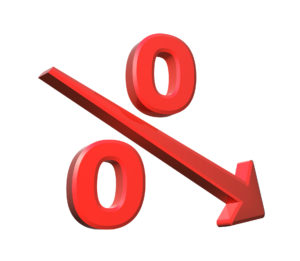
There are cases when the taxpayer stops paying the tax altogether. The termination of the payment of TN is carried out in the following cases:
- if the taxpayer has already paid the tax;
- if the death of the FL occurred (the heir owed by the TN must pay);
- if other circumstances arise that are spelled out in article 44.
Organizations can lower rates. To do this, you can use:
- re-registration of your car in another region;
- payment of duty at rates that are intended for FL;
- deferred payment due to transit numbers;
- making necessary changes to the technical documentation of the vehicle, whose power is more than 300 horsepower;
- delay the registration of the vehicle;
- other legal ways.
If we are talking about a faulty vehicle, the issue of non-payment of tax can be resolved by removing the vehicle from registration. In order to do this, the following documents should be provided to the traffic police:
- number plates;
- papers confirming registration;
- technical certificate.
For legal entities the car can be removed from the registration to use it exclusively in the production area.
Calculators
 In order to find out the value of the tax, you can use calculator for calculating TN. The main one is on the Tax Service website.
In order to find out the value of the tax, you can use calculator for calculating TN. The main one is on the Tax Service website.
For example, you live in the Samara region and are the owner of a passenger car with a capacity of 57 kJ.
In this case, the car in your property for more than two years. For the calculation of the TN should go to the section of the Samara region on the website of the tax service, choose the type of vehicle "Cars", enter the power of transport 77,49834 hp (57 * 1.35962 hp), and then click on the button "Calculate".
As a result, for 2017 you will have to pay a TH in the amount of 239.97 rubles.
Benefits and payment terms
In order for the privilege to be credited to the payment of the transport tax, it is necessary to submit to the tax documents in time, which would confirm that the taxable citizen really has the right to the privileges.
All necessary documents should be submitted at the place of residence of the citizen, on which the car is issued. An application is submitted, as well as papers, due to which a benefit would be confirmed.
So, what benefits are provided for in the Russian Federation? The following groups of citizens are exempted from payment in full:

However, the benefits for the above citizens are provided only for one vehicle, of the following groups:
- passenger vehicles whose power is not more than 100 horsepower;
- motorcycles with no more than 40 horsepower;
- boats equipped with a motor, or boats whose power does not exceed 30 horsepower;
- Self-propelled vehicles or tracked or pneumatic vehicles, whose power does not exceed 100 horsepower.
In addition, those citizens who are owners of vehicles, whose power is less than 80 horsepower, and the release date - until January 1, 1991, do not pay TN. At the same time, the owner should not pass technical inspection even in the last three years.
Recently, there are benefits for large families (from three children or more). In this case, the exemption applies only to passenger vehicles, whose power does not reach 100 horsepower, and buses with a capacity of less than 150 horsepower.
- Organizations of persons with disabilities that use the CU to perform statutory activities.
- Organizations involved in leasing operations.
- Agricultural organizations with a fleet of trucks.
- Businesses that contain troop convoys.
If we talk about the category of beneficiaries as pensioners, then for them there is also a discount of 50% on. The following cars are eligible:
- The passenger mode of transport, whose power does not reach 100 horsepower.
- Motorcycles, whose power is up to 40 horsepower.
- Boats whose engine power is not more than 40 horsepower.
- Self-propelled vehicle on tracked and pneumatic, with a power of up to 100 horsepower.
Producers of agricultural goods, whose share of profits is from 70 to 90%, pay a third of the transport tax. However, this rule only applies to trucks.
If we talk about the timing of payment, individuals should pay TN until October 1 of that year, which immediately follows the expired tax period. However, before you pay the tax, receive notice.
As for before, they pay tax for reporting periods, but no later than February 1 (if legal entities decide to pay tax once a year).
General transport tax information can be obtained from this video.

